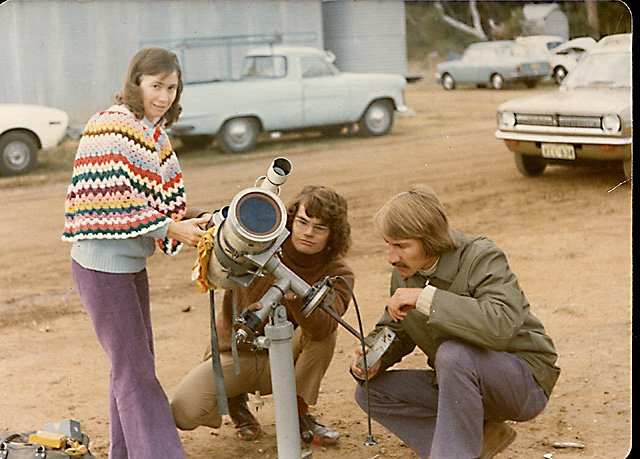
Attaching the movie camera to the telescope required some improvisation!
Note the lack of shadows! After a perfect morning, clouds had appeared!
The total solar eclipse of June 20, 1974, was eagerly awaited by observers in Western Australia, as the southern tip of the state was one of the few places in the world where the eclipse path would be visible over land. As it was, only the northern portion of the shadow would pass over land. The centreline and the southern portion were over the ocean. Even so, totallity would last for more than 3 1/2 minutes.
In preparing for the eclipse, the biggest concern was for the weather. June 20 is in the middle of winter and June is one of the wettest months for the southern part of the state. Initial studies were not promising, with the long term avarage being over 70% chance of cloud! However more detailed studies be several members of the Astronomical Society of Western Australia, found that unless there was a cold front approaching from the ocean, the high ground of the Cape Leewin peninsula would break up any cloud, and so there was about a 50% chance of clear skies in this area. As a result, the society arranged to use the airstrip of the nearby town of Augusta for observing the eclipse. By agreement with the local avaition bureau, the airstrip would be close to planes from an hour before the eclipse was due to start, until an hour after the eclipse was over. This was to ensure that there would be no dust from planes landing on the gravel strip.
The days leading up to the eclipse were full of anticipation and concern. Day after day produced clear blue skies, without a hint of any clouds or rain. The record for consecutive days in June without any rain (18) was reached 2 days before the eclipse! It was the first time that no rain had been recorded in the first 2 1/2 weeks of the month. Each day cold fronts would approach the coast and then be steered south away from the state. The farmers were getting very worried, and so were the astronomers! When would the clear run end???
The day of the eclipse dawned fine and sunny again, with the only concern being smoke from nearby bushfires as farmers did some late burning off. However even the wind was co-operating by blowing the smoke away from where the Sun would be during the eclipse. Arriving at the airstrip, everyone was quick to set up their equipment and start looking at the Sun. My main aim was to film the eclipse with an 8mm movie camera I had aquired a few months before. Finances would only allow for 1 roll of film, so I decided to use most of it during totality. At the time I did not have a 35mm camera that I could couple to the telescope, so I decided to use the telescope to view the eclipse and not do any still photography.
I had arranged with a friend from the society to use his mount for my telescope as his mount had a motor drive. Something not very common in Perth in those long ago days! This brought the first problem..... His telescope was an 8" newtonian. Much larger and heavier than my 5" refractor. So there was a problem with balancing! Then there was the problem of how to attact the movie camera to the side of the telescope. In the end, it was achieved by strapping the camera with a belt, and using a "T" shirt to cushion the camera against the telescope tube!

While all this was going on, some thin cloud decided to sneak up over the Sun. For quite a while there was much discussion about what to do. Shuld we try an pack up and head east along the coast in search of a clear patch of sky? Or should we stay put and hope that the range of hills would do their stuff and clear the cloud? In the end, everyone decided it would be better to stay and hope. By now there were over 100 people scattered along the airstrip, waiting and hoping.
About 10 minute before first contact the clouds started to break up, and when first contact occured (to a great cheer of excitement!) the sky was clear once again.
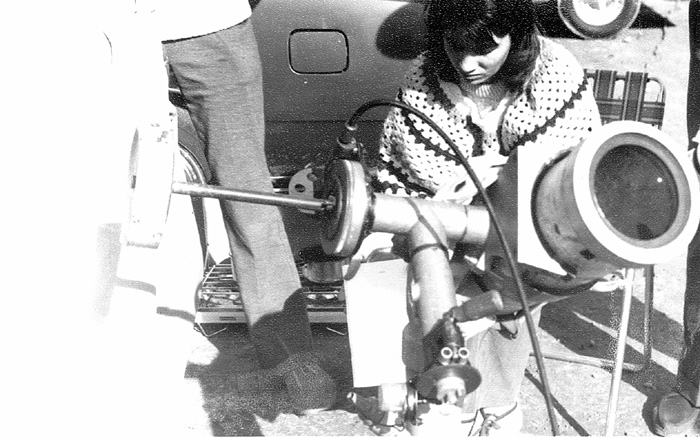
As more and more of the Sun was covered the excitement grew. The change in the light was most strange and is something that was difficult to describe. The shadows remained sharp however the light was deminished like it was becoming cloudy. Many people had fun looking at the shape of the sunlight shining through the leaves of nearby bushes, and everyone was walking around seeing what everyone else was trying to do.
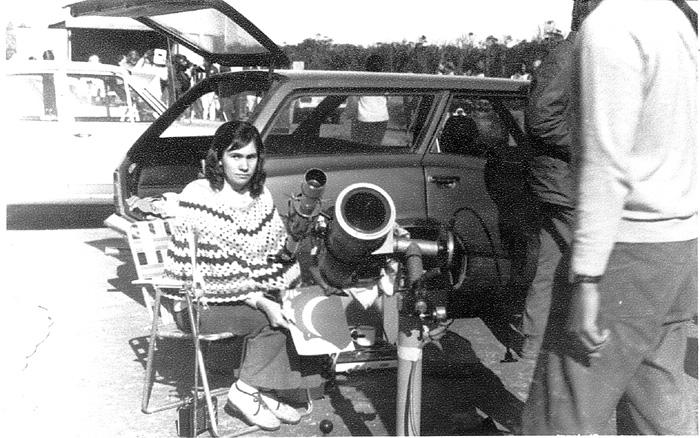
As the last thin cresent of the Sun disappeared, there was a great cheer. It was hard to know what to watch. The onrushing shadow of the moon, or the fast disappearing cresent of the Sun! In the end, I opted to watch the Sun. The sight of the cresent shrinking so fast was fantastic. However, that sight paled into insignificance at my first look at the eclipsed Sun in my telescope! The black disk of the Moon, the red prominences, and the beautiful and detailed corona, was a sight that I have never forgotten! It was without a doubt the most beautiful astronomical sight I have ever seen. I found myself wishing that I did have a 35mm camera that I could attach to the telescope to photograph the sight. As it turned out however, not having a camera did have one big benefit. Instead of spending all my time on taking pictures, I was able to spend my time just looking and enjoying the sight. Also it was good that my telescope had a 50mm guidescope. It meant that twice as many people were able to have a look! One interesting incident that I noticed during totallity, someone was taking photographs using a flash! this brought a roar of displeasure from those trying to observe nearby!!!
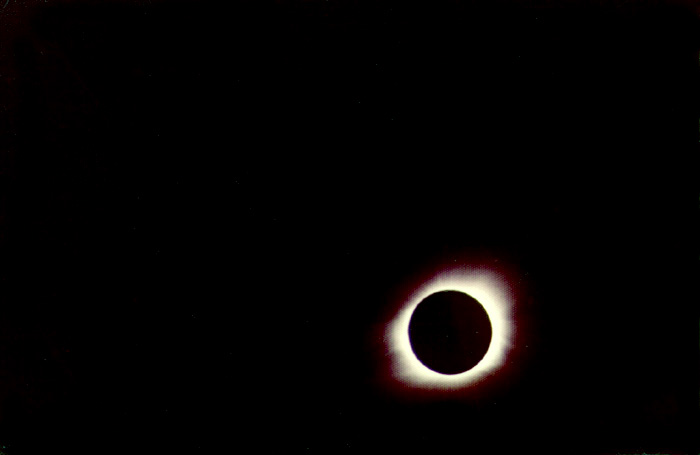
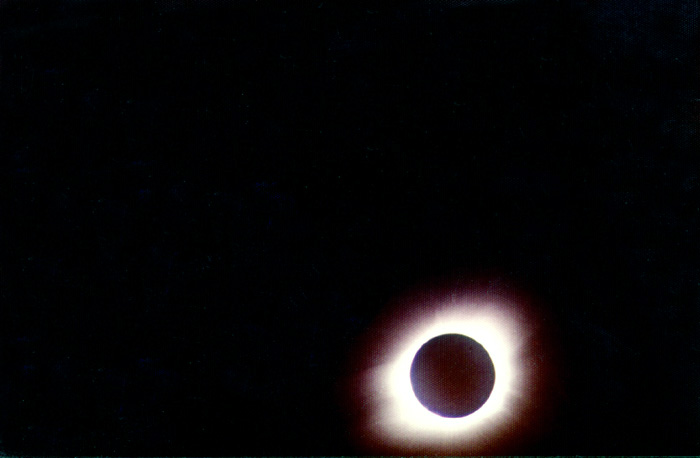
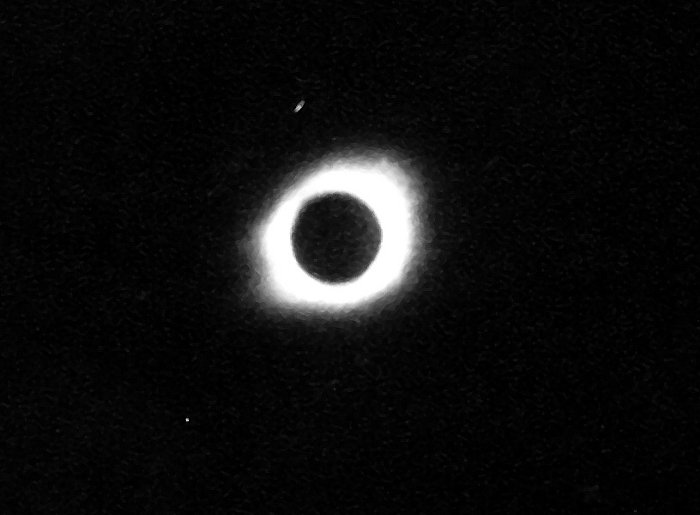
Someone had set up a PA system near where the telescopes were set up, to count down the time of totality. As we entered the final 30 seconds of totality everyone joined in the countdown! Just as totality ended were we treated to a find display of the Diamond Ring. This brought the largest cheer of the day, and much applauding.
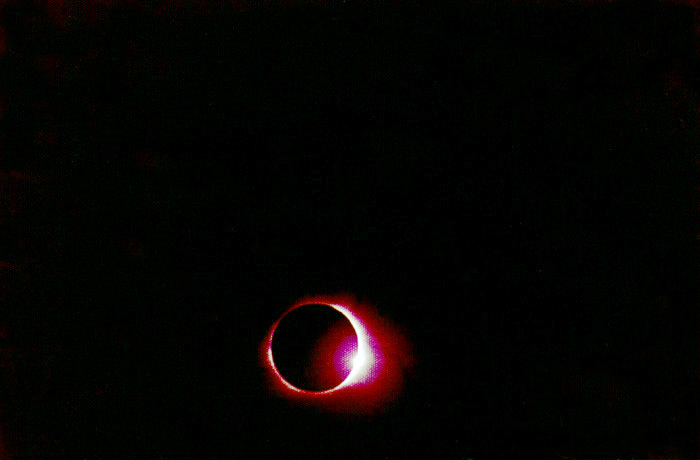
After totallity ended, very few people were interested in observing the partial phases. Almost everyone was far too excited and wanting to discuss the sight. However most people did not leave until after 4th contact. The most frequent comment was how fortunate we had been to have had perfect skies. The research by those members a couple of years earlier had been spot-on! As we found out later, many other places to the east had been plagued by cloud, and that virtually no-one else had such a clear view of the eclipse. A little over 24 hours later, the clear skies ended and the winter rains began in ernest.
Once I had my movie film developed, I was overjoyed to see that everything had worked. However there was one problem. The camera had no way of overriding the automatic light meter, and as a result, the lens was opened wide. This meant that the inner corona was badly overexposed, although it did provide an excellent view of the very long corona streamers. One day it is my intention to take a few frames from the film and scan them. Unfortunately at the moment the film is in storage back in Australia. So it could be some time before this gets done!